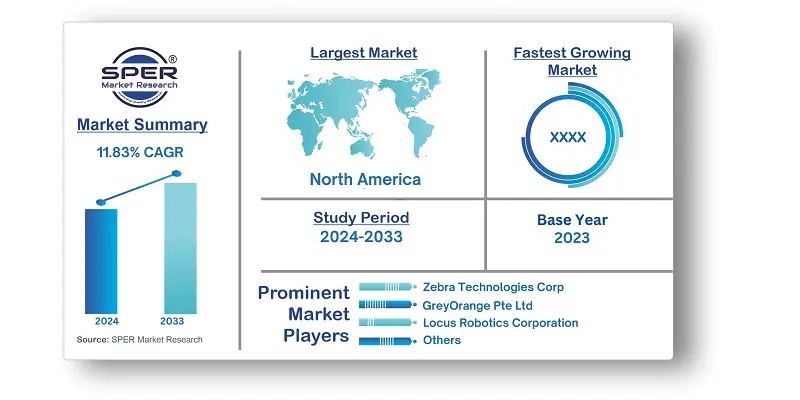
United States Warehouse Robotics Market Growth, Size, Trends, Share, Revenue and Future Outlook
United States Warehouse Robotics Market Size- By Type, By Function, By End User- Regional Outlook, Competitive Strategies and Segment Forecast to 2033
| Published: Jun-2024 | Report ID: AMIN24151 | Pages: 1 - 104 | Formats*: |
| Category : Automotive & Transportation | |||
- FANUC Corp., a global pioneer in CNCs, robotics, and ROBOMACHINEs, will unveil two new high-payload capacity collaborative robots at Automate 2023 in May 2023. The CRX-25iA cobot demonstrated its amazing 30kg payload capacity by expertly handling a 30kg kettlebell with full wrist movement. This demonstration showcased FANUC's comprehensive portfolio of advanced automation solutions geared to boost production and efficiency across a variety of industries.


| Report Metric | Details |
| Market size available for years | 2020-2033 |
| Base year considered | 2023 |
| Forecast period | 2024-2033 |
| Segments covered | By Type, By Function, By End User |
| Regions covered | North, South, West, Mideast |
| Companies Covered | Zebra Technologies Corp, GreyOrange Pte Ltd, Locus Robotics Corporation, inVia Robotics, Inc, FANUC America Corporation, OMRON Corporation, Yaskawa America, Inc, Honeywell International Inc. |
- E-commerce Companies
- Retailers
- Logistics and Distribution Companies
- Manufacturing Companies
- Third-Party Logistics (3PL) Providers
- Warehouse and Fulfillment Center Operators
- Robotics Manufacturers
- Technology and Automation Solution Providers
- Investors and Venture Capitalists
- Consulting and Integration Firms
- Government and Regulatory Bodies
- Research and Development Institutions
| By Type: |
|
| By Function: |
|
| By End User: |
|
- United States Warehouse Robotics Market Size (FY’2024-FY’2033)
- Overview of United States Warehouse Robotics Market
- Segmentation of United States Warehouse Robotics Market by Type (Articulated, Gantry, Automated Storage and Retrieval System (ASRS), Mobile, Others)
- Segmentation of United States Warehouse Robotics Market by Function (Storage, Trans-shipments, Packaging, Others)
- Segmentation of United States Warehouse Robotics Market by End User (Food and Beverages, Automotive, Retail, Electronics and Electrical, Pharmaceuticals, Others)
- Statistical Snap of United States Warehouse Robotics Market
- Expansion Analysis of United States Warehouse Robotics Market
- Problems and Obstacles in United States Warehouse Robotics Market
- Competitive Landscape in the United States Warehouse Robotics Market
- Impact of COVID-19 and Demonetization on United States Warehouse Robotics Market
- Details on Current Investment in United States Warehouse Robotics Market
- Competitive Analysis of United States Warehouse Robotics Market
- Prominent Players in the United States Warehouse Robotics Market
- SWOT Analysis of United States Warehouse Robotics Market
- United States Warehouse Robotics Market Future Outlook and Projections (FY’2024-FY’2033)
- Recommendations from Analyst
1.1. Scope of the report1.2. Market segment analysis
2.1. Research data source2.1.1. Secondary Data2.1.2. Primary Data2.1.3. SPER’s internal database2.1.4. Premium insight from KOL’s2.2. Market size estimation2.2.1. Top-down and Bottom-up approach2.3. Data triangulation
4.1. Driver, Restraint, Opportunity and Challenges analysis4.1.1. Drivers4.1.2. Restraints4.1.3. Opportunities4.1.4. Challenges4.2. COVID-19 Impacts of the United States Warehouse Robotics Market.
5.1. SWOT Analysis5.1.1. Strengths5.1.2. Weaknesses5.1.3. Opportunities5.1.4. Threats5.2. PESTEL Analysis5.2.1. Political Landscape5.2.2. Economic Landscape5.2.3. Social Landscape5.2.4. Technological Landscape5.2.5. Environmental Landscape5.2.6. Legal Landscape5.3. PORTER’s Five Forces5.3.1. Bargaining power of suppliers5.3.2. Bargaining power of buyers5.3.3. Threat of Substitute5.3.4. Threat of new entrant5.3.5. Competitive rivalry5.4. Heat Map Analysis
6.1. United States Warehouse Robotics Market Manufacturing Base Distribution, Sales Area, Product Type6.2. Mergers & Acquisitions, Partnerships, Product Launch, and Collaboration in United States Warehouse Robotics Market
7.1. United States Warehouse Robotics Market Size, Share and Forecast, By Type, 2020-20267.2. United States Warehouse Robotics Market Size, Share and Forecast, By Type, 2027-20337.3. Articulated7.4. Gantry7.5. Automated Storage and Retrieval System (ASRS)7.6. Mobile7.7. Others
8.1. United States Warehouse Robotics Market Size, Share and Forecast, By Function, 2020-20268.2. United States Warehouse Robotics Market Size, Share and Forecast, By Function, 2027-20338.3. Storage8.4. Trans-shipments8.5. Packaging8.6. Others
9.1. United States Warehouse Robotics Market Size, Share and Forecast, By End User, 2020-20269.2. United States Warehouse Robotics Market Size, Share and Forecast, By End User, 2027-20339.3. Food and Beverages9.4. Automotive9.5. Retail9.6. Electronics and Electrical9.7. Pharmaceuticals9.8. Others
10.1. United States Warehouse Robotics Market Size and Market Share
11.1. United States Warehouse Robotics Market Size and Market Share By Region (2020-2026)11.2. United States Warehouse Robotics Market Size and Market Share By Region (2027-2033)11.3. Mid-East11.4. West11.5. North11.6. South
12.1. Zebra Technologies Corp12.1.1. Company details12.1.2. Financial outlook12.1.3. Product summary12.1.4. Recent developments12.2. GreyOrange Pte Ltd12.2.1. Company details12.2.2. Financial outlook12.2.3. Product summary12.2.4. Recent developments12.3. Locus Robotics Corporation12.3.1. Company details12.3.2. Financial outlook12.3.3. Product summary12.3.4. Recent developments12.4. inVia Robotics, Inc12.4.1. Company details12.4.2. Financial outlook12.4.3. Product summary12.4.4. Recent developments12.5. FANUC America Corporation12.5.1. Company details12.5.2. Financial outlook12.5.3. Product summary12.5.4. Recent developments12.6. OMRON Corporation12.6.1. Company details12.6.2. Financial outlook12.6.3. Product summary12.6.4. Recent developments12.7. Yaskawa America, Inc12.7.1. Company details12.7.2. Financial outlook12.7.3. Product summary12.7.4. Recent developments12.8. Honeywell International Inc12.8.1. Company details12.8.2. Financial outlook12.8.3. Product summary12.8.4. Recent developments12.9. Others
SPER Market Research’s methodology uses great emphasis on primary research to ensure that the market intelligence insights are up to date, reliable and accurate. Primary interviews are done with players involved in each phase of a supply chain to analyze the market forecasting. The secondary research method is used to help you fully understand how the future markets and the spending patterns look likes.
The report is based on in-depth qualitative and quantitative analysis of the Product Market. The quantitative analysis involves the application of various projection and sampling techniques. The qualitative analysis involves primary interviews, surveys, and vendor briefings. The data gathered as a result of these processes are validated through experts opinion. Our research methodology entails an ideal mixture of primary and secondary initiatives.



Frequently Asked Questions About This Report
PLACE AN ORDER
Year End Discount
Sample Report
Pre-Purchase Inquiry
NEED CUSTOMIZATION?
Request CustomizationCALL OR EMAIL US
100% Secure Payment






Related Reports
Our Global Clients
Our data-driven insights have influenced the strategy of 200+ reputed companies across the globe.






















